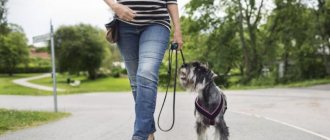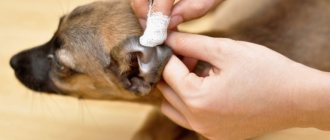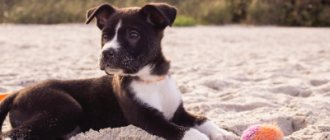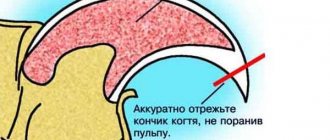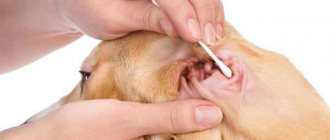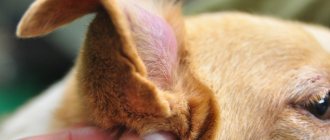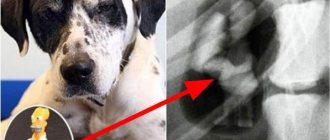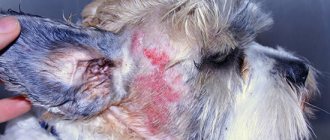The main causes of injuries on the front and hind legs
An active and agile dog can break a claw in a wide variety of situations - while chasing a cat or in a fight with relatives, or in an unsuccessful jump from a height. A common cause of injury is the tendency of many dogs to dig holes in hard ground and sand. Having caught on snags, bumped into hard objects with their paws, stones, bricks, the claws are the first to break and break.
Old animals are predisposed to orthopedic problems due to the development of dryness of not only the skin, but also the stratum corneum. Brittle and dry claws will break off sooner or later.
Keeping pets in a dry room, especially in winter when central heating is on, is often accompanied by claw injury. As a rule, a dog’s extra claws are susceptible to the problem, since the support claws grind down naturally and do not stick out to the sides.
Veterinary experts believe that an unbalanced diet and the presence of diseases of the endocrine system and internal organs can lead to damage. Thus, with a deficiency of vitamin A, biotin, B vitamins, zinc, selenium, and iron, separation of the stratum corneum, dryness and brittleness of the nails are noted.
Dog “manicure” also suffers from diseases of the thyroid gland, disorders of mineral metabolism, and liver pathologies.
We recommend reading about how to stop bleeding in a dog. From the article you will learn how to stop stomach bleeding, bleeding from the mouth, nose, nails and uterus.
And here is more information about a broken paw in a dog.
Signs that a dog has a broken nail
The injury received by an animal, as a rule, does not go unnoticed by attentive owners. The animal, which previously ran carefree during a walk or indoors, begins to limp. The dog tries not to step on the injured limb and keeps it suspended. Many individuals try to lick the painful area. Due to the fact that animal claws are equipped with blood vessels, their damage is most often accompanied by bleeding.
Upon visual inspection, the owner will find that the nail is either broken or completely torn out from the nail fold. The damage should be examined very carefully, as the slightest touch brings severe pain to the pet.
How to help a dog at home?
When a dog is in pain, it may behave inappropriately, so it is advisable to use:
- Muzzle.
- Leash.
- Durable gloves.
First of all, inspect the damaged area. Try not to touch the paw more than necessary at this stage. The goal is to determine if there is a hanging fragment of the claw remaining that needs to be removed.
If the broken or cracked claw is still there, you will need to remove it. It is better to use sharp scissors. Be prepared for increased bleeding when removing the claw fragment.
First aid: what painkiller to give, how to treat
Having discovered an injury, the owner must competently provide first aid to his four-legged friend. If the damage is accompanied by bleeding, then first of all measures are taken to eliminate it. It is best to examine a restless individual with an assistant who will hold the dog firmly during manipulations.
First, you need to inspect the wound for the presence of foreign objects - glass and metal fragments, wood chips, splinters, thorns, sharp thorns, pine or spruce needles, plant seeds.
Bleeding from a damaged claw can be removed in several ways: using a hemostatic pencil, hydrogen peroxide, baby powder, potassium permanganate solution. To quickly stop bleeding, apply a pressure bandage or gauze.
The most crucial moment when providing first aid to an animal is removing a broken nail. If the injury occurred closer to the end of the horn formation, then you can break off the damaged area using special nail clippers. Use a nail clipper to remove the hanging fragment with a quick but confident movement.
As a rule, such manipulation is painful for the dog, but the pain is immediate. If the damage is located near the base of the claw, you should not carry out the manipulation yourself.
The owner's next step should be to prevent infection of the open injury by infectious factors. A feature of the anatomical structure of the claw is its connection with the bone structures of the limb.
Therefore, it is important to prevent dirt from getting into the wound. To this end, the owner must carry out antiseptic treatment of the damaged area. This can be done with the help of antibacterial compounds - Miramistin, Chlorhexidine solution, Furacilin. If you have a special iodine-based wound remedy in your medicine cabinet - Monclavit - then its simple and convenient use will facilitate antiseptic treatment.
If possible, the open injury can be sprinkled with streptocide powder. If you have an anti-inflammatory ointment on hand, for example, Levomikol, Tetracycline, then you can also use a creamy form of antiseptic. The paw should be placed in a clean cotton sock or bandaged to prevent the wound from becoming infected.
Cleaning and disinfection
Cleaning and disinfection of the wound can only begin after bleeding has completely stopped. If you do not have a pharmacy antiseptic, you can use a weak solution of sea salt. The wound should not be treated with iodine, alcohol or brilliant green!
You cannot do without the help of a veterinarian if:
- Dirt got into the injured claw - earth, sand, various chemicals, feces.
- There is a foreign object in the wound - a splinter, grass, small stones.
- The bleeding does not stop for more than 10 minutes.
- The dog lost more than 50 ml of blood.
- The paw is noticeably swollen.
- The external temperature of the limb has changed.
- The skin on the paw turned blue.
- The dog cannot calm down - howls, whines, and rushes about.
- In addition to the claw, a finger was damaged.
After treatment, the wound must be protected from licking and contamination. To prevent your dog from licking his paw and removing the bandage, you need to use an Elizabethan collar.
The bandage is worn on an ongoing basis only for the first 24 hours, after which the wound must be given the opportunity to “breathe.” It is strictly not recommended to wet the wound until it has completely healed. To protect paws in rainy weather, you need to use oilcloth or rubber covers.
Contacting a veterinarian for a claw injury
Considering the complex structure of the claws, their proximity to bone formations, the risk of infection and the development of inflammation of surrounding tissues, after first aid is provided, the animal must be taken to a specialized institution. Qualified help is necessary for incessant bleeding, severe lameness that does not go away over time.
You should also contact a veterinarian if the claw is damaged in close proximity to the paw.
During the examination, the doctor will first clean the wound and perform an antiseptic treatment. If the pain is severe, the animal will be sedated to remove the broken claw. The manipulation is carried out with a special surgical instrument, which allows you to quickly and without dissecting the stratum corneum to trim the damaged claw. Then the bleeding is stopped and an aseptic bandage is applied to the paw.
Broken Claw
Orthopedic trauma in an animal is associated with severe pain. In some cases, a veterinarian uses painkillers - Baralgin, Spazgan - to reduce the pet's suffering.
After claw removal
If there is a threat of penetration of pathogenic microorganisms into deep tissues, the furry patient is prescribed a course of antibacterial drugs. For preventive purposes, antibiotics with a wide spectrum of action are used - Baytril, Cobactan, Cefatoxime.
Recommendations for further treatment of the wound surface depend on the degree of damage. As a rule, care consists of applying an anti-inflammatory ointment to the wound, for example, Levomycetin, Ichthyol, Vishnevsky's liniment.
The animal should be given complete rest and the duration of walks should be reduced. To speed up wound healing, a veterinarian may recommend enriching your pet’s diet with vitamins A and E, biotin, selenium, zinc, and sulfur using multivitamin and mineral supplements.
To see what can happen if you don’t remove a dog’s broken claw, watch this video:
How to avoid problems?
Caring for them should be a mandatory procedure. Trim your nails regularly to reduce the risk of breaking or breaking your nails. To do this, choose a nail clipper that suits your dog at the pet store.
The structure of a dog's claw is much more complex than that of many other animals and, even more so, than the structure of a human nail. Without going into details, you can divide it into the claw bed or, in other words, the pulp (inner layer) and the keratin sheath, which is located on the outside.
When cutting, it is very important not to touch the pulp, but to cut exactly the outer layer, parallel to the floor, so that the dog can walk comfortably.
If your pet's claws have no color , then it will be easy for you to determine the boundary of the layers, and therefore to carry out a quality trim. You can see the pulp by laying the dog on its back and looking at the inside of the paw.
If they are painted , then this border may not be visible, which complicates the process. Remember that only the keratinized tip of the claw should be cut off, being careful not to touch the soft tissue.
You will have to practice for some time before the procedure begins to be carried out by you properly and is perceived calmly by the animal. Of course, if you are afraid of the sight of blood ( being inexperienced, you can touch the capillaries ), you are afraid of harming your pet by doing something wrong, then it would be best to contact a specialist.
Prevention of nail damage in dogs
Considering the prevalence of the problem, orthopedic veterinarians and experienced dog breeders recommend that owners of four-legged friends adhere to the following rules for care and maintenance:
- Trim overgrown nails regularly. The overgrown stratum corneum clings to hard surfaces and sooner or later will lead to injury. Neglecting this simple hygiene procedure will protect your dog from painful injuries.
- The manipulation should be carried out using a special tool for trimming animals. The nail clipper should be made of high-quality metal, which will prevent the occurrence of hangnails and delaminations when trimming the nail. Particular attention should be paid to additional claws, which, due to their physiological characteristics, grow faster.
- The animal's diet must be balanced in nutrients, vitamins and microelements.
- In winter, when keeping dogs in heated rooms, it is recommended to humidify the air using an air conditioning system and sprayers.
We recommend reading about eye injury in dogs. From the article you will learn about the causes of eye injuries in dogs, types of injuries, diagnosis of the condition of the cornea and other parts of the eye, and treatment.
And here is more information about how to treat a dog’s wound.
A broken claw can cause serious problems for your four-legged friend in the form of bleeding and pain. The owner’s task is to be able to competently provide first aid to the animal and deliver it to the clinic as soon as possible. An examination by a veterinarian is necessary if there is bleeding from the wound, severe lameness and pain.
Treatment consists of complete or partial removal of the damaged nail, stopping bleeding and antiseptic treatment of the wound.
Useful video
To learn how to properly trim a dog's nails, watch this video:
Similar articles
- Cracks on dogs' paws, pads: causes...
...damaged skin treated with an antiseptic and fixed with gauze... Trim the dog's claws in a timely manner, as when they grow excessively, injuries... Read more - How to stop bleeding in a dog if it...
Dogs often get injured while walking, fighting with relatives, or chasing cats. ... Damaged claw with a careful but confident movement... Read more
- A broken paw in a dog: how to determine the front...
A limb fracture in dogs is a serious injury characterized by pain and loss of the injured paw’s support function. Read more
- How to treat a dog’s wound, treat purulent, lacerated...
A dog's rough tongue irritates damaged tissues and leads to infection of a clean wound. Read more
- Eye injury in a dog: causes, treatment, dog after...
Eye injury from a cat's claw. ... Dogs can scratch the damaged organ with their paws and thereby worsen the situation. Read more
